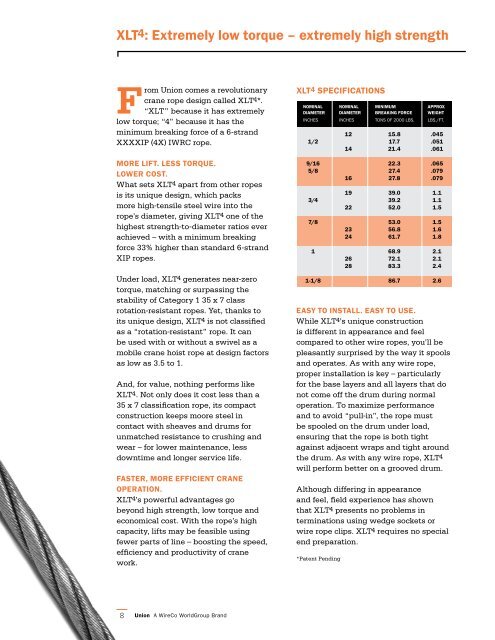Crane User's Guide - Union Wire Rope
Crane User's Guide - Union Wire Rope
Crane User's Guide - Union Wire Rope
You also want an ePaper? Increase the reach of your titles
YUMPU automatically turns print PDFs into web optimized ePapers that Google loves.
Xlt4: extremely low torque – extremely high strength<br />
From <strong>Union</strong> comes a revolutionary<br />
crane rope design called XLT 4*.<br />
“XLT” because it has extremely<br />
low torque; “4” because it has the<br />
minimum breaking force of a 6-strand<br />
XXXXIP (4X) IWRC rope.<br />
more lift. less torqUe.<br />
lower Cost.<br />
What sets XLT 4 apart from other ropes<br />
is its unique design, which packs<br />
more high-tensile steel wire into the<br />
rope’s diameter, giving XLT 4 one of the<br />
highest strength-to-diameter ratios ever<br />
achieved – with a minimum breaking<br />
force 33% higher than standard 6-strand<br />
XIP ropes.<br />
Under load, XLT 4 generates near-zero<br />
torque, matching or surpassing the<br />
stability of Category 1 35 x 7 class<br />
rotation-resistant ropes. Yet, thanks to<br />
its unique design, XLT 4 is not classified<br />
as a “rotation-resistant” rope. It can<br />
be used with or without a swivel as a<br />
mobile crane hoist rope at design factors<br />
as low as 3.5 to 1.<br />
And, for value, nothing performs like<br />
XLT 4. Not only does it cost less than a<br />
35 x 7 classification rope, its compact<br />
construction keeps moore steel in<br />
contact with sheaves and drums for<br />
unmatched resistance to crushing and<br />
wear – for lower maintenance, less<br />
downtime and longer service life.<br />
faster, more effiCient <strong>Crane</strong><br />
oPeration.<br />
XLT 4’s powerful advantages go<br />
beyond high strength, low torque and<br />
economical cost. With the rope’s high<br />
capacity, lifts may be feasible using<br />
fewer parts of line – boosting the speed,<br />
efficiency and productivity of crane<br />
work.<br />
8<br />
Xlt4 sPeCifiCations<br />
nominal nominal minimUm aPProX<br />
diameter diameter breaking forCe weight<br />
InchES InchES TOnS OF 2000 LBS. LBS./FT.<br />
12 15.8 .045<br />
1/2 17.7 .051<br />
14 21.4 .061<br />
9/16 22.3 .065<br />
5/8 27.4 .079<br />
16 27.8 .079<br />
19 39.0 1.1<br />
3/4 39.2 1.1<br />
22 52.0 1.5<br />
7/8 53.0 1.5<br />
23 56.8 1.6<br />
24 61.7 1.8<br />
1 68.9 2.1<br />
26 72.1 2.1<br />
28 83.3 2.4<br />
1-1/8 86.7 2.6<br />
easy to install. easy to Use.<br />
While XLT4’s unique construction<br />
is different in appearance and feel<br />
compared to other wire ropes, you’ll be<br />
pleasantly surprised by the way it spools<br />
and operates. As with any wire rope,<br />
proper installation is key – particularly<br />
for the base layers and all layers that do<br />
not come off the drum during normal<br />
operation. To maximize performance<br />
and to avoid “pull-in”, the rope must<br />
be spooled on the drum under load,<br />
ensuring that the rope is both tight<br />
against adjacent wraps and tight around<br />
the drum. As with any wire rope, XLT 4<br />
will perform better on a grooved drum.<br />
Although differing in appearance<br />
and feel, field experience has shown<br />
that XLT 4 presents no problems in<br />
terminations using wedge sockets or<br />
wire rope clips. XLT 4 requires no special<br />
end preparation.<br />
*Patent Pending


